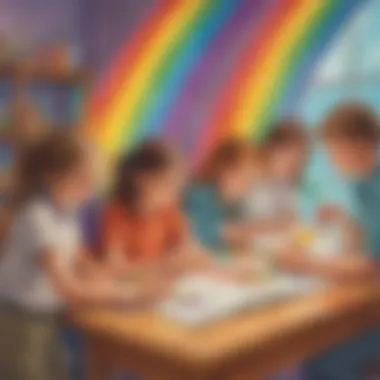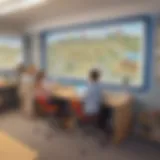Climbing Rainbow Experiment: A Colorful Science Dive


Intro
The Climbing Rainbow Experiment invites us on an enlightening journey into the realm of science, brilliantly marrying principles of capillary action with color mixing. This hands-on experiment does not only captivate the imagination but extensively enlightens young minds about fundamental scientific concepts in an engaging manner.
Through the interaction of colored water and absorbent materials, children grasp how liquids move upward mysteriously as if they are climbing. This vibrant display serves as both decoration and education, setting the stage for deeper scientific discussions.
As we dissect this exciting experiment, we will highlight key points to focus on during execution, covering essentials from materials selection to potential variations. Ultimately, our goal is to equip educators and parents with the knowledge needed to turn abstract theories into observable phenomena, fostering curiosity and understanding in future scientists.
Interactive Learning Games
Integrating existing knowledge with play can significantly enhance learning outcomes. Educational games, designed to stimulate cognitive growth while being entertaining, create an ideal environment for children to discover science hands-on.
Popular Games
Some enjoyable educational games include:
- Osmo Genius Starter Kit
- Rush: A Disney Pixar Adventure
- Kerbal Space Program
- Kahoot!
These games incorporate vital principles of learning, aiming to link complex concepts with playful execution.
Description of Top Educational Games
- Osmo Genius Starter Kit: Engages children in technology combined with physical interaction. It’s suitable for subjects like math and spelling.
- Rush: A Disney Pixar Adventure: This game accommodates teamwork while teaching process thinking and problem solving.
- Kerbal Space Program: Excellent for older children, this games mixes outer space concepts with physics applications through simulation and exploration.
- Kahoot!: A quiz-based app that allows educators to create fun learning sessions, enhancing knowledge recall and classroom engagement.
Benefits of Playing Educational Games for Kids' Cognitive Development
- Engaging in problem-solving challenges fosters critical thinking skills.
- The cooperative gameplay enhances collaboration and communication among children.
- Educational mechanics improve knowledge retention.
- Children often experience a reduction in learning anxiety through the play approach.
Game Reviews
Osmo Genius Starter Kit
The innovative interface gives children a tactile experience with learning, drawing them into various subjects. Teachers have highlighted its adaptability to different learning levels.
Rush: A Disney Pixar Adventure
Satisfying reviews point to its rich graphics and plot-driven immersive scenes promoting teamwork. Children often learn creativity alongside game mechanics.
Kerbal Space Program
Critics note its high level of realism in flight simulations. Engaging children’s interest in aerospace while nestled within exciting game narrative has produced promising educational gains.
Kahoot!
Feedback underscores its effectiveness in reinforcing learning through joyful participation. The platform easily adapts to various topics and keeps the competition light-hearted yet rewarding.
Comparison of Gameplay and Learning Outcomes
It’s essential users choose games with a balance between enjoyable gameplay and educational value. Engaging discussions in educational circles often surface concerning how gaming elements can be synergized with educational standards.
Didactic games like Kahoot! lean heavily on collaborative engagements. Reflection is where games like Kerbal Space Program shine by enhancing critical application of knowledge.
Guiding children toward understanding the principles of science, much like with the Climbing Rainbow Experiment, enhances both their learning experience and retention of each lesson shared. This interplay defines a sound alternative to traditional methods, emphasizing connections that often spark longer-term curiosity.
Educational Topics
Research supports that a broad spectrum of skills enriches intellectual development. Cross-disciplinary education invites children to think outside compartmentalized boxes.
Compilation of Articles Covering Various Subjects
A collection of resources can support quality interdisciplinary learning:
- Science Journals: Explains new findings.
- Mathmagician: Focus on fun math tricks.
- Multilingual Matters: The importance of learning a language.
Importance of Interdisciplinary Learning
Integrative education shapes a well-rounded learner instead of niche-focus kids. Children energize curiosity when exercises overlap various concepts. The excitement ignites when patterns arise between subjects that appear dissimilar.


Tips and Tricks
Here are essential strategies for parents and educators advanced in leading kids through hands-on science activities.
Practical Tips for Parents and Educators
- Make simplicity a priority. Begin with common materials.
- Encourage questions. Always explore ‘why’ behind the phenomena rather than giving direct answers.
- Build curiosity through observation. Ask children to make predictions.
Strategies for Making Learning Fun and Engaging
- Turn experiments into contests to foster friendly competition.
- Introduce challenges to investigate variables creatively.
- Document findings with drawings and notes, allowing exploration without pressure.
Creative DIY Projects
Experimentation often leads to creativity. Associating theoretical concepts with practical project work causes practical application to flair well apart from traditional learning methods.
Step-by-Step Guides
Provide clear instructions when asking kids to engage in DIY activities. Encouraging creativity through foundations cement observational skills.
Benefits of Hands-On Activities
Concrete engagement significantly develops cognitive and motor skills. Children learn better through exploring Numerous materials and engaging activities pave their paths.
Craft Ideas
Recycling materials adds value to crafting his ideas. Use paper towel, food color, or simple containers every day to empower expression.
- Design colorful pouring stations.
- Create artistic representations the principles of the capillary actions, drawing engagement through science and handiwork.
In vital experiences like Climbing Rainbow Experiment, artistic interpretation diversifies lessons and brightens them while boosting interest and creativity.
Preamble to the Climbing Rainbow Experiment
The Climbing Rainbow Experiment is an intriguing educational activity that introduces fundamental scientific concepts to young learners. It creates a visually engaging platform, allowing children, parents, and teachers to observe and understand the principles of capillary action and color mixing in a fun and interactive way. Through this experiment, individuals can also foster a deeper appreciation for the science that shapes our everyday experiences, providing a gateway to further exploration into the natural world.
Purpose and Benefits
The primary purpose of the Climbing Rainbow Experiment is to ignite curiosity among children regarding scientific phenomena. By incorporating color and movement in the demonstration, the experiment holds an inherent charm that captivates attention. The experiment illustrates key scientific principles, stimulating interest that may lead to a lifetime of inquiry and learning.
The benefits include:
- Visualization: Children can see how colors travel through absorbent material, which aids comprehension of often abstract concepts.
- Practical Learning: Engaging in hands-on activities encourages participation and allows for experiential learning, an effective way to retain new information.
- Critical Thinking: By posing questions and hypothesizing outcomes, children enhance their analytical skills.
When designed with structured guidance and safe practices, educators and parents can utilize this exercise to help children learn numerous scientific principles while motivating them to explore beyond the classroom.
Overview of Capillary Action
Capillary action is a fundamental principle responsible for the movement of liquids within a material. This phenomenon occurs due to the interactions between adhesive forces, where the liquid molecules are attracted to the surface of the material, and cohesive forces, which bring the liquid molecules together.
In the context of the Climbing Rainbow Experiment, the absorbent material—often paper towels or filter paper—serves as the medium through which water carrying different hues climbs upwards.
As water is drawn up into the fibers of the material, it transports the colorants along with it, creating a striking effect reminiscent of a rainbow.
By understanding capillary action, children will grasp not only how this specific experiment functions, but also how various materials, such as soil and plants, rely on similar principles to sustain life. Ultimately, delving into capillary action enriches a child's scientific literacy and promotes a reasoned understanding of fluid dynamics.
Materials Required
The discussion around the Climbing Rainbow Experiment begins with the materials needed for such an engaging and scientific exploration. Adequate knowledge of materials is not just a precondition—it's a cornerstone for the entire experiment. Gathering the right materials fosters a smoother process, ensuring that curious minds experience the joy of discovery without unnecessary hurdles.
Using well-chosen materials adds to the reliability of results. Additionally, understanding each component's role can enhance both learning and execution. A clear outline of these materials also helps set expectations and aids in better planning.
Basic Supplies
To effectively conduct the Climbing Rainbow Experiment, specific basic supplies are essential. Below is a list:
- Clear plastic cups: These allow for easy observation of color movement while being low-cost.
- Paper towels: The critical element in facilitating the capillary action—the stiff paper facilitates color absorption.
- Water: This is the foundational solvent used, its properties directly influence the rising colors.
- Scissors: For cutting paper towels and necessary medicates to size needed for clean and easy handling.
Learning to assemble this basic set of supplies cultivates an appreciation for the structure behind scientific experimentation. It offers a hands-on approach to science that can deeply engage children through tangible actions. In the process, educators, parents, and caregivers play an important role in guiding children through these materials, enriching their understanding and excitement about science.


Colorants and Solutions
Choosing appropriate colorants enhances the visual experience of the Climbing Rainbow Experiment while simultaneously teaching students about color mixing and basic chemistry. Various options are available, which can serve different preferences:
- Food coloring: Commonly used, food coloring offers safe, vivid options for your colors. It provides excellent visibility as it merges along each paper towel strip.
- Liquid watercolors: A bit deeper in shade and historically often used for artistry, these can convey even bolder results. They also allow for a range of combinations.
- Homemade color solutions: Personalizing colors merely using natural elements sets an enriching challenge. Ingredients like beet juice or turmeric provide additional learning on sources of color.
Selecting color components is essential, as this not only contributes to the aesthetic appeal but accompanies physical interaction with concepts like separation. Understanding how colors behave illustrates complex scientific principles—simple to observe yet sophisticated in thought, encouraging the child-inquiry of color mixing with water.
Effective selection of materials bridges the gap between the ordinary and the extraordinary in learning.
Step-by-Step Instructions
Step-by-step instructions are essential in conducting the Climbing Rainbow Experiment. They ensure that procedures are clear and replicable. For educators and parents, following a systematic approach facilitates a deeper understanding of the scientific principles involved. Establishing clarity minimizes mistakes, especially when working with children, who may need more detailed guidance. This transparency aids in fostering a reliable educational atmosphere.
Setting Up the Experiment
Setting up the Climbing Rainbow Experiment involves methodically preparing your workspace and materials. First, gather all necessary supplies. You will need clear cups, paper towels, water, and food coloring or liquid watercolors. Arrange your cups in a row, ensure they stand firm, for this will affect the results of your experiment.
It is crucial to put an equal amount of water in each cup, around halfway full. Adding food coloring to every second cup creates the pathway for the colors to travel via capillary action. Allowing the colors to intermingle requires a clear plan, so ensuring measurement precision cannot be overlooked. This initial setup lays the groundwork for a successful execution and guarantees expected outcomes.
Initiating the Color Climb
Once the setup is ready, it is time to initiate the color climb. This step is where the magic begins as students observe the movement of colors. Connecting the cups together with folded paper towels is key. Lay a towel across neighboring cups so one end of the towel dips into colored water and the other remains in a clear cup.
As the paper towel absorbs water, you will notice the liquid traveling through the fibers. Carefully observing the progression of colors makes the experience interactive. This step engages children’s curiosity about how separate colors can mix through simple materials, reflecting principles of capillary action beautifully.
Observing the Changes
Observing changes during this experiment creates excitement and wonder. Over a period of time, note how far the colors travel upwards through the paper towels. Children should be encouraged to document their findings, perhaps with sketches or written observations. Taking the time to notice small details, like the gradual blending of colors, signals a focus on scientific inquiry.
Through highs and lows of colors diffusing through the towels, questions should arise. Why do certain colors travel faster? What roles do evaporation and gravity play? Engaging in conversation about these elements enhances critical thinking. Understanding dynamics between the observed results and underlying scientific principles solidifies the educational impact of this experiment.
This experiment not only illustrates scientific principles but also builds inquiry skills through observation and documentation, helping young minds to question and explore further.
Scientific Principles Behind the Experiment
The Climbing Rainbow Experiment provides an engaging method to explore crucial scientific principles like capillary action, cohesion, and adhesion. Understanding these concepts helps both children and caregivers appreciate the fascinating behaviors of liquids in various environments. By focusing on cohesive and adhesive forces at play in the experiment, participants gain insights into how different substances interact with water, making the learning process visual and manageable for a younger audience.
This section offers critical explanations that elevate the experiment from mere observation to an informative scientific study. Encouraging young minds to look deeper into the mechanisms involved assists in building scientific reasoning, fostering a sense of inquiry that can lead to a greater curiosity about the natural world.
Understanding Cohesion and Adhesion
Cohesion and adhesion are essential concepts that can often appear complex but can be understood through observations in simple experiments.
- Cohesion refers to the attraction among molecules of the same substance. In the case of water, it enables molecules to stick together, resulting in a surface tension that can hold drops together. This property makes water droplets form shape, which gives students a notion of how water behaves in different conditions.
- Adhesion, on the other hand, describes the attraction between different substances. When water interacts with materials such as paper towels or cloth, it shows good adhesion, allowing the liquid to climb up or spread out.
Together, these forces make the colorful journey of the dye in the Climbing Rainbow Experiment possible. As water rises in the materials used, students can draw a visual connection to how these forces function in the realm of science.
Role of Water Molecules
Water molecules are a foundational aspect of the Climbing Rainbow Experiment, playing a vital role in observing capillary action.
Water is composed of two hydrogen atoms and one oxygen atom, collectively forming O. This unique structure provides several important characteristics:
- Polar Nature: Each water molecule has a slight positive charge on one side and a slight negative charge on the other, facilitating hydrogen bonding. This chaining effect helps them move together, which enhances cohesion.
- Small Size: Being small allows water molecules to move through tiny spaces in other materials. This is precisely what happens in the climbing rainbow.
- Imposing Solvent Properties: Water has the capacity to dissolve numerous substances. By adding colorants, children see firsthand how colors can blend and diffuse vividly within water, visually displaying the scientific phenomenon.
Understanding the roles of water molecules is fundamental. As children observe a color climb, they also witness the intricate mechanisms of science that can occasionally be overlooked in more complex scenarios.
In summary, a firm grasp of these concepts equips participants with skills to observe, think critically, and reflect upon scientific occurrences all around them, cultivating a lifelong interest in science.
Variations of the Experiment
Variations of the Climbing Rainbow Experiment not only enhance engagement but also deepen understanding of essential scientific concepts. These adjustments allow participants to explore more on the principles of capillary action, color mixing, and the chemical properties of various substances. Taking small liberties with the basic procedure provides an opportunity for creativity and critical thinking. Examining different angles will facilitate a more profound comprehension of the principles involved.
Incorporating Different Colors
The process of incorporating different colors in the Climbing Rainbow Experiment enriches the learning experience. By selecting a diverse range of dye colors, participants get the chance to witness exciting results. Experimenting with combinations can yield unique patterns and shades, prompting discussions on color theory should arise. Below are a few points to consider while incorporating colors:
- Explore color combinations: Instead of just one hue per dye solution, combining two or more dyes can result in a vivid interaction of colors. Observing how orange combines with blue or yellow blends with green could open discussions about primary and secondary colors.
- Use natural colors: Apart from synthetic colorants, using natural dyes from fruits, vegetables, or even spices offers a different perspective. Beet juice, turmeric, and spinach create varied tones. Moreover, discussing the sources and make-up of these colors reinforces lessons about biology and chemistry.
- Changing UV indicators: Some colorants change hue when exposed to light. Such as neon dyes. Observing their behaviors under different light can stimulate curiosity.


With a focus on these distinct colors and mixtures, educators can facilitate an engaging activity providing sensory experiences alongside scientific principles.
Using Alternative Materials
Engaging students with alternative materials and tools can provide fresh insights into the Climbing Rainbow Experiment. Straying from the typical ingredients encourages resourcefulness and creativity. Some considerations include:
- Experiment with different substrates: While paper towel strips are classic for this experiment, using materials like cloth or sponge alters absorption qualities. The varying rates of capillary action will lead to a stimulating observing session.
- Modify container shapes: Trying different container shapes and sizes can drastically impact the results. For instance, narrow tubes compared to wider containers can lead to fascinating discussions about how geometry influences water movement.
- Add household items: Introducing materials such as oil can show disparities in viscosity compared to water. Mixing can encourage discussions on liquids and create visual representations of immiscible liquids.
Utilizing a diverse range of materials will help participants to think artistically while reinforcing core scientific principles.
Remember that by embracing these variations, students will come to recognize science as an evolving discipline. They can contribute to the discussions about hypotheses, results and possibly share their findings with others.
Educational Implications
The Climbing Rainbow Experiment is more than a fun activity; it holds significant educational value. Engaging with this experiment promotes various learning outcomes that extend beyond simple observation. Although the vibrant colors mesmerize, the implications for education emphasize greater intellectual development through inquiry and critical thinking.
Encouraging Inquiry-Based Learning
Inquiry-based learning is a pedagogical approach where students actively participate in the learning process. During the Climbinfg Rainbow Experiment, students can explore questions like "Why do the colors mix or rise in the way they do?" This method fosters curiosity, allowing children to express their thoughts and hypotheses.
- Hands-on experience is instrumental in inquiry-based activities. As students set up their experiment, they interact with materials, making hypotheses and predictions.
- Exploring visually through transformations appeals to their senses, helping cement knowledge faster than traditional rote learning.
By incentivizing students to ask questions, educators create an environment where children feel confident to experiment.
Fostering Critical Thinking Skills
Critical thinking skills are essential for assessing information and solving problems. Through the climbing nature of tri-colored mixtures, participants assess variations of color movement and question possible variables.
- Students learn to analyze differences resulted by changes, such as the amount of water or placement of papers. As a result, they develop the ability to discern cause from effect.
- Evaluating outcomes enables kids to reflect on their predictions, urging them to reassess their conclusions logically and coherently.
- This natural reflection and dialog with peers encourage collaborative discussions, where differing viewpoints can arise and be examined.
Critical thinking unlocks new layers of understanding and stimulates further investigation regarding the scientific notions behind simple visual trends.
Overall, the Climbing Rainbow Experiment serves as a conduit for broader educational discussions, engaging young minds in a scholarly adventure.
Safety Considerations
Safety is essential in any scientific experiment, especially when working with younger audiences. This article, focusing on the Climbing Rainbow Experiment, recognizes the importance of prioritizing safety throughout the process. Addressing safety concerns not only protects participants but also enhances their learning experiences by fostering a sense of responsibility and awareness. By encouraging safe practices, we create an environment where curiosity can thrive without undue risk.
General Laboratory Safety
Basic laboratory safety is the foundation for conducting any experiment successfully. A set of straightforward guidelines ensures that participants can follow procedures without jeopardizing their health or safety. Here are key safety rules that should be observed in connection with the Climbing Rainbow Experiment:
- Wear Personal Protective Equipment (PPE): Always have participants wear safety goggles and aprons. These items protect eyes and skin from spills and stains.
- Keep Work Areas Clean: A tidy workspace reduces the likelihood of accidents. Make sure all materials are organized before starting.
- Avoid Consumption of Lab Materials: Participants should never taste or ingest substances used in the experiment. It's crucial to explain this rule clearly to children.
- Properly Dispose of Waste: Ensuring that all materials, especially colorants, are disposed of in designated containers is another safety measure to maintain cleanliness and prevent contamination.
Adhering to these principles can make a significant difference. They minimize any potential hazards, allowing students to focus on discovery and understanding.
Handling Colorants Safely
Colorants, often used in the Climbing Rainbow Experiment, need particular attention. Diverse colorants can present various challenges when not handled properly. Educators should keep in mind the following safety tips:
- Check Material Safety Data Sheet (MSDS): Every colorant or chemical should come with an MSDS detailing its hazards and safety information. Review this before the experiment.
- Use Non-Toxic Colorants: Whenever possible, opt for safe, non-toxic colorants specifically designed for educational purposes. These are available in craft or educational supply stores. Examples include food coloring or liquid watercolors.
- Manage Spills Immediately: Prepare for accidents. Have paper towels or cloths available to clean spills quickly to avoid slips or stains.
- Wash Hands After Experimentation: Proper hand hygiene can prevent ingestion of residues. Teach participants to wash hands thoroughly after completing any experiment.
Finales and Final Thoughts
The Climbing Rainbow Experiment highlights essential scientific concepts through a hands-on approach. Understanding the underlying mechanisms can enhance the learning experience while ensuring these principles resonate with young minds.
Educational experiments like this foster a genuine interest in science, making learning more interactive and visually engaging. Such projects illustrate the significance of capillary action, drawing attention to both scientific theory and practical applications. Encouraging children to take part in these learning experiences promotes better retention and comprehension.
Experimentation leads to understanding, which is foundational in scientific education.
Recap of Key Concepts
The central ideas explored within the Climbing Rainbow Experiment are as follows:
- Capillary Action: The ability of liquids to flow in narrow spaces against external forces, highly relevant in various biological and physical processes.
- Color Mixing: The blending of different colors provides insight into both the properties of light and the interaction of different pigments.
- Cohesion and Adhesion: These concepts define how molecules interact with each other, crucial for understanding many phenomena in daily life.
Through careful representation of these principles, students can grasp not only basic science, but also cultivate a sense of curiosity and discovery, which is vital for future learning.
Future Learning Opportunities
The completion of the Climbing Rainbow Experiment opens several pathways for extended exploration. Parents and educators can build off this foundational knowledge through various methods, including:
- Experiment Variations: Adjusting colorants or materials can demonstrate how changes impact the boiling, freezing, or even evaporation rates of liquids.
- Scientific Journals: Encouraging children to document their observations helps instill a practice that sharpens analytical skills and scientific reasoning.
- Group Discussions: Sharing results and methods fosters critical thinking, collaboration, and communication.
- Incorporating Technology: Online simulations or educational videos related to the principles observed can create deeper understanding and broaden thematic connections.
The key lies in fostering an environment where questioning, experimenting, and reflecting come naturally, laying a groundwork for lifelong learning in the sciences.















